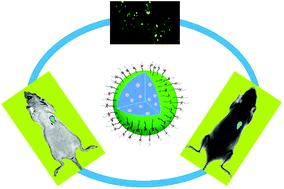One-pot synthesis of PEG modified BaLuF5:Gd/Yb/Er nanoprobes for dual-modal in vivo upconversion luminescence and X-ray bioimaging†
Abstract
Polyethylene glycol (PEG) modified BaLuF5:Gd/Yb/Er upconversion nanoparticles (UCNPs) were synthesized by a facile one-pot hydrothermal method for simultaneous synthesis and surface functionalization. The novel, excellently biocompatible and water-soluble bioprobes were used for simultaneous upconversion (UC) luminescence and X-ray bioimaging for the first time. The as-prepared BaLuF5:Gd/Yb/Er UCNPs possess a face-centered cubic structure with an average size of 23.7 ± 2.7 nm. Under 980 nm laser excitation, these UCNPs emitted intense UC luminescence via a two-photon process. In vitro bioimaging and localized luminescence spectra detected from HeLa cells and the background reveal that these UCNPs are ideal candidates for optical bioimaging in the absence of autofluorescence. Furthermore, the synergistic in vivo UC luminescence and X-ray bioimaging reveal that these PEG-modified BaLuF5:Gd/Yb/Er UCNPs can be successfully used as ideal dual-modal bioprobes. These results demonstrate that these PEG modified UCNPs are ideal multi-modal nanoprobes for bioimaging.


 Please wait while we load your content...
Please wait while we load your content...